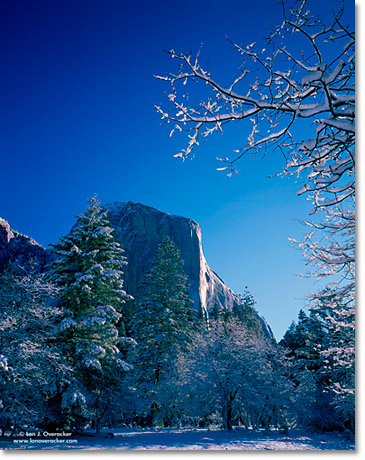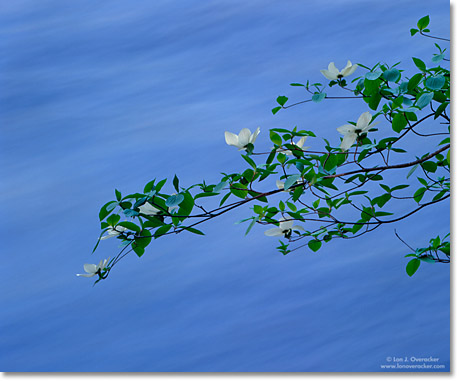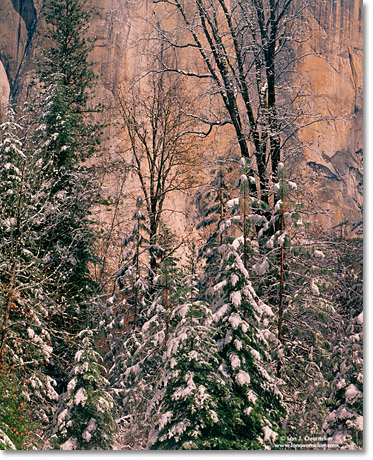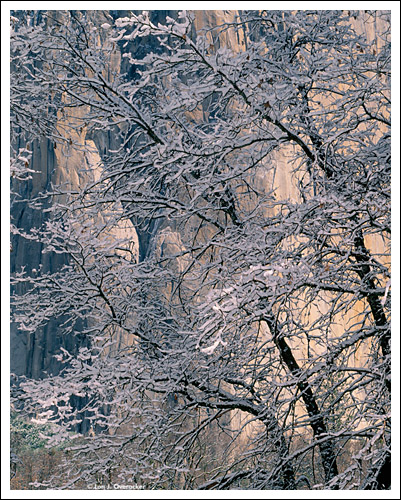The title of this article alone will surely make many of you think, "Please don't tell me this guy is going to tell me how to go chasing tripod holes or even think about advocating it." I'll let you decide in the end, but the intent here is to simply share with you one of those moments where one's photography makes a transformation - or as I now refer to it as a "light bulb moment." And part of that moment for me includes a confession, and if at least one person can learn something from this, then my trip to the confessional was worth it.
To start, I think it should be clear that in my opinion there is a difference between photographing popular, iconic places and capturing images that have been done thousands of times before, and actually setting out to "copy" someone else's work. When a photographer visits a place for the first time, and perhaps a once in a lifetime chance, it's quite natural that they will want to capture a classic or iconic view. You can be sure that when and if I get to visit Zion National Park, I will undoubtedly come across many of the scenes that have already been photographed to death. The difference here being that I am not setting out to copy a scene. If it's beautiful, dramatic or catches my eye, I'm likely to try and capture it.
Much has been written about finding one's own "vision" or "style." A recent example is an article by Michael Gordon posted on NPN. In a nutshell, he talks about a number of things a photographer can do to "step out of the box" and learn to find his or her own vision. I certainly agree that one should seek to make their own path, be different, and try to find their own photographic and artistic voice. And whether stated or implied, we also should know that we don't develop our vision in a vacuum. The influences in our lives, our culture, upbringing, and the visuals stored in the recesses of our brains, will always influence the direction we take with our art. We see countless images of the slot canyons, El Capitan, Delicate Arch, and the Subway. And when you visit one of those iconic places for the first and perhaps only time, there's little or no way to get around those influences. Creating something unique and different will be a difficult chore. It's probably why we see so many similar images from these iconic locations. And that's okay. They're iconic locations for a reason.
Familiarity Breeds Creativity
Sounds like an oxymoron doesn't it? It could be taken that way if you consider how many images you've seen from Tunnel View in Yosemite or the same old viewpoint of Delicate Arch. Familiarity can create cliches and breed boredom. So how can it breed creativity? In this case, familiarity means an intimate knowledge of your subject. The once-in-a-lifetime trip to Denali or Victoria Falls doesn't come with the familiarity of knowing, understanding, and experiencing all the nuances of a place over time. Of course you can circumvent that by paying a guide, who has that knowledge and experience. But in general, when you may only have a few hours or a couple days at an unfamiliar location, you are bound to come away with classic views and little in the way of originality. And again, that's okay.
Being knowledgeable and familiar with your subject is nothing new and is probably the most obvious in wildlife photography. Knowing the subject's environment, eating, sleeping, and breeding habits are key to any successful wildlife photographer. The same is also true for the nature and landscape photographer. Understanding the light, weather, conditions, times of day, seasons, etc. all play a key role in helping you as a photographer step beyond the ordinary and begin taking those steps towards a vision and style you can call your own.
I consider myself fortunate to live only a few hours away from Yosemite Valley. I'm fortunate that I don't have to travel half way across the globe to see some of Nature's most beautiful and inspiring creations. The same can be said if you live in Southern Utah, the Great Smoky Mountains, or within a short car ride to the Columbia Gorge or Olympic National Park. Then again, you don't have to live next to one of these natural wonders of the world. Beauty and inspiration are all around us, no matter where you live. For a great example, visit Dan Baumbach's website and his "My Home Town" gallery.
I've been photographing in Yosemite for over twenty years and I guess by default, I've become pretty familiar with the subject, especially Yosemite Valley. At times, I've even come to the point where I can walk the El Capitan meadow and not even look up at that giant monolith. Been there, done that. Over time, I've learned when the morning light hits certain parts of the valley or how long other parts will remain in shade. I know that autumn doesn't really kick in until early November and the dogwood blooms start coming out the middle of April. I know that if it's raining and about 40 degrees or colder at my house on Friday night, there's a very good chance there will snow on the Valley floor Saturday morning.
Has my familiarity of Yosemite made me a better photographer or given me my own style? I don't know, but I can say that my photography has certainly improved over time. It's a lifelong process and perhaps I'm still looking to identify what my vision is. I do know that my familiarity, or more accurately, my love and passion for the "Incomparable Valley," have allowed me to "see" and photograph things that I would not have seen ten or twenty years ago.
 The Confession
The Confession
It's inevitable that I have become so familiar with Yosemite that when I see an image taken in Yosemite Valley, I can usually figure out where it was taken. Such was the case in winter of 1998 when I made my way to Yosemite right after a winter storm. And as usual, I took a break to grab lunch at Degnin's Deli in Yosemite Village and take a short stroll to see what was hanging at the Ansel Adam's Gallery. For those of you who have never been, the Ansel Adam's Gallery is more of a gift shop than a dedicated art gallery. Sure, you'll find original Adam's prints, copies and the works of William Neill, Michael Frye, Keith Walklet, Galen Rowell and his famous image of Horsetail Falls. But this is also a place with glass showcases of jewelry, pottery, Indian crafts, and of course hundreds of photo books, note cards, and poster prints. Every couple of months they rotate photography and art work of other renowned Yosemite artists. It so happened that at the time of my visit they were exhibiting the works of Charles Cramer. Just up the steps and hanging next to the bookcase was a print that caught my eye. It must have been 32"x40," and I was awestruck. The color, lighting and most notably, the detail of this huge print was incredible. My visits to art and photography galleries of any note were quite limited, but this was the most incredible print I had yet to see with my own eyes. With permission from Mr. Cramer, please view this image on his website. Of course the small web sized version doesn't do this justice, but being able to see it is at the crux of my story.
I didn't come to Yosemite seeking out to copy anyone's image, but the moment I saw this image, I knew exactly where it was taken. Familiarity. The conditions were right as it had just snowed the day before and snow still clung to the branches of the trees. I knew the location was on the Southside Drive which stays in shadow longer and there would still be snow. I took it as a challenge to see if I could find the exact location.
 With only the image pressed in to my mind, I found the location and did my best to frame the same composition. The light was favorable. I attached the 210mm lens to the 4x5 and moved the tripod several times trying to gain the same vantage point. Under the dark cloth, composing and focusing, a feeling of violation started creeping in. What was a challenge or game now became an uneasy feeling that I was simply copying someone else's work. I stepped back and thought to myself, "This isn't right." I placed the film holder in the camera anyway and then tried to justify taking the picture. Maybe the challenge was to see how much detail I could get from the scene; a test of my own abilities and those of the camera, lens and film. Who knows? I pressed the cable release and captured this image. Who would ever know unless I told someone? Well, I'm telling you now. I confess.
With only the image pressed in to my mind, I found the location and did my best to frame the same composition. The light was favorable. I attached the 210mm lens to the 4x5 and moved the tripod several times trying to gain the same vantage point. Under the dark cloth, composing and focusing, a feeling of violation started creeping in. What was a challenge or game now became an uneasy feeling that I was simply copying someone else's work. I stepped back and thought to myself, "This isn't right." I placed the film holder in the camera anyway and then tried to justify taking the picture. Maybe the challenge was to see how much detail I could get from the scene; a test of my own abilities and those of the camera, lens and film. Who knows? I pressed the cable release and captured this image. Who would ever know unless I told someone? Well, I'm telling you now. I confess.
The Transformation
Feeling guilty, I packed up the camera and decided to take the short walk down to the Merced River in hopes I could find something different and unique - kind of a wakeup call, you might say. Not more than fifty or so yards from where I had just tried to copy someone else's image, I came upon a beautiful oak tree all dressed in its winter coat - snow layered on top of every single branch. I started thinking about composition options, what was attracting me to the scene, and how best to capture what I was now seeing. Familiarity was breeding boredom, however. El Capitan loomed large over the scene and I didn't need another wide-angle image with El Capitan. It was at this point that I started looking at the scene within the scene. It wasn't just the snow on the branches, but the glow of El Capitan that was so striking.
Familiarity was now breeding creativity. I could use the famous landmark as a backdrop or accent and not necessarily as the main subject. And remembering back only a few minutes earlier, it was the light on El Capitan that gave Charlie Cramer's image such a wonderful glow. So, in perhaps an unconventional and dubious manner, I was beginning to "see" things differently in Yosemite. Images were becoming whole scenes, not just a subject. Paying attention to the background and all the elements has helped me create unique images in a place that has been overrun with photography for over a century.
This image of "Branches and Snow" is perhaps one of my all time personal favorites. The transformation and lessons learned on this day took my photography to a new level and continues to make photography in Yosemite an invigorating and enjoyable experience.

More images from Yosemite can be seen on my website. Thank you!
Comments on NPN landscape photography articles? Send them to the editor. NPN members may also log in and leave their comments below.
Lon Overacker is a large format nature and landscape photographer from Livermore, CA. From an early age, Lon has always loved nature and the great outdoors; capturing nature's beauty on family vacations, backpacking trips and really anywhere where light and subjects meet. In the early 1990's, long before digital photography hit the scene, Lon made the jump from 35mm to large format 4x5 photography in order to compete in the "world of pretty pictures." Today, Lon continues capturing moments in time using film and the 4x5 format. He finds that the slower, contemplative pace allowed him to grow and learn as a photographer and he truly enjoys what he does.
For more information or to see the collection of Lon's images, please visit his website at www.lonoveracker.com.